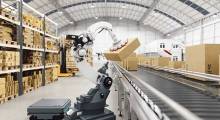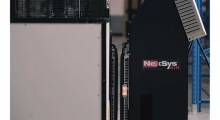Traditional order fulfillment or parts picking is a human-only task - involving finding, selecting and gathering specific items within a warehouse and combining them into an order or kit. Even with highly skilled warehouse workers, human error is inevitable - particularly in operations with limited personnel, unorganized inventory, fluctuating demand or new employees being trained.
Poor pick accuracy (aka mispicks) can lead to costly consequences, manufacturing line stoppages and unhappy customers.
To improve this time-consuming activity, warehouses are leveraging automation and technology to streamline picking activities resulting in decreased training hours, increased picking productivity, and better overall inventory control.
The future of order picking in warehouses will be shaped by advancements in automation and robotics, data analytics, smart data, artificial intelligence (AI), and predictive modeling. These advancements directly impact the following four trends warehouses are adopting at a rapid pace:
- Automated picking
- Wearable technology
- Augmented and mixed reality
- Natural user interfaces
Automated Picking
Automated storage and retrieval systems (ASRS) work in combination with the human workforce to reduce mispicks and improve order picking accuracy. ASRS adds further value to picking operations by providing compact storage and space optimization while reducing labor and costs.
Warehouse picking robots – aka pick and place robotics - can fully automate order picking, depalletizing, and putaway/replenishment by picking, handling, and placing individual items, cartons, and entire totes. For example, picking robots can pick individual unique items stored in the ASRS and place it in the correct location for a fully automated order picking solution with maximum accuracy.
By leveraging the automatically logged data, utilizing smart data and machine learning - the robot continuously enhances the picking process, optimizes fulfillment, and increases throughput over time. The integrated pick and place robot can manage picking tasks without any human intervention, providing a great solution to organizations facing accuracy issues, labor shortages and training challenges.

Wearable Technology
Wearable technology, such as smart glasses, headsets, or wristbands, introduces another realm of possibilities for warehouse operations. This integration enables users to interact with virtual objects through clicks, voice commands, or gestures. For instance, glasses can seamlessly integrate digital information or virtual objects into the user’s field of vision.
Wearable scanners in the form of rings or bracelets provide real-time feedback, reducing the chances of errors stemming from manual data entry. By eliminating manual input, wearables allow operators to concentrate on picking while keeping their hands free.
Augmented and Mixed Reality
Augmented reality (AR) and mixed reality (MR) technologies have the potential to revolutionize warehouse operations. These technologies integrate digital elements such as sounds, visuals, or graphics into a real-world view.
These applications provide operators with visual instructions and real-time feedback. This is particularly beneficial when operators are unfamiliar with specific products or processes, as they reduce human errors by providing intuitive guidance and contextual information – increasing overall pick accuracy.17
Looking ahead, we can expect AR and MR to play an even more significant role in automated picking in logistics. These innovations hold tremendous potential to transform the industry, making order fulfillment more precise, faster and increasingly efficient.

Natural User Interfaces
Natural user interfaces (NUI) is a concept that combines the natural abilities of humans with technology, enabling seamless interaction between users and automated systems.19 By incorporating elements such as gesture recognition, voice commands, touch interfaces, and augmented reality, NUI enhances the accessibility, user-friendliness, and efficiency of automated picking, ultimately improving the overall experience for warehouse operators.
The advancements in this field have paved the way for Kardex’s newest innovation, the Intuitive Picking Assistant. This cutting-edge picking solution revolutionizes warehouse operations by projecting relevant picking information directly onto the operator’s workstation. Projection picking facilitates ergonomic, fast, and error-free picking, eliminating the requirement for additional displays or keyboards.
The Intuitive Picking Assistant ensures operators are guided seamlessly through the picking process, receiving real-time guidance and confirmation for each step. This streamlined approach reduces the need for extensive training, allowing operators to quickly adapt to the system and perform their tasks with increased efficiency. Furthermore, the Intuitive Picking Assistant enhances ergonomics by minimizing repetitive motions and optimizing workstation design, improving the operators’ overall performance.

Future Outlook
Leveraging these trends, workforces will be empowered rather than replaced. By implementing automation and robotic systems warehouses can expect high performance levels leading to more precise order fulfillment and ultimately increased customer satisfaction.
Recognizing these advantages, logistics and fulfillment companies are proactively investing in automation with plans to allocate 30% or more of their capital expenditure over the next five years specifically to automation initiatives. This proportion is the highest among all industrial segments, underscoring the industry’s strong commitment to harnessing the transformative power of automation to drive efficiency, productivity, and competitiveness.
Learn more about Kardex and their products.
Article topics
Learn More










